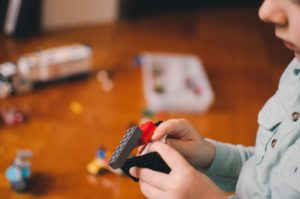Katie is a 9-year-old girl who always seems to be daydreaming. No matter how hard she tries to pay attention in class, her mind still wanders. She finds herself thinking about all the things she’d like to do later or planning a fun game to play with her friends at recess.
Katie gets frustrated and anxious because when her mind wanders, she doesn’t understand how to do the set work and she forgets to write down homework assignments.
 The struggles Katie has don’t stop at school. They affect her home life, too. For example, she really wants to work hard and focus on getting her math homework finished. However, when she sits down, she realizes the lead has snapped in her pencil. She goes to get her sharpener, but when she opens the desk drawer, she realizes how messy it is and starts to tidy it.
The struggles Katie has don’t stop at school. They affect her home life, too. For example, she really wants to work hard and focus on getting her math homework finished. However, when she sits down, she realizes the lead has snapped in her pencil. She goes to get her sharpener, but when she opens the desk drawer, she realizes how messy it is and starts to tidy it.
As Katie tidies the desk drawer and the desk itself, she finds a small toy that she used to play with when she was smaller. She starts to think about the fun she had playing with it. Half an hour later, her mom comes into the room expecting to find Katie working on her math homework. Instead, Katie is sitting on the floor and smiling as she gazes at the toy. Santa Monica Christian Counseling helps families manage distractions and improve focus.
Katie’s mom is not impressed. It is really frustrating for Katie’s mother because Katie takes so long to finish her homework. Not only that, but Katie forgets to do chores, is always losing things, and doesn’t seem to be able to focus on anything. Her mom has tried everything to try to keep Katie motivated to finish tasks, but nothing works.
Nico is an 8-year-old boy who never seems to stop moving. He tries really hard to sit still, but he always feels jittery. That means that he’s always getting told off for getting up out of his seat in class or at church. He gets into trouble for talking to his buddies when he’s supposed to be listening to his teacher.
It seems like Nico has an unlimited supply of energy. His parents and teachers get frustrated because he’s always interrupting conversations. In class, his teacher has been trying to get Nico to stop blurting out answers rather than raising his hand and waiting to be asked. It’s not working. Nico can’t seem to help himself.
Nico feels like there’s something wrong with him, and he feels guilty for being so bad. He just can’t control his reactions. He tries to follow the rules and he wants to please his mom and dad and his teachers, but there’s something inside him that makes it almost impossible. He’s always beating himself up for getting into trouble. He wonders why he can’t be like the other kids.
Do these hypothetical examples sound familiar? Both Katie and Nico have Attention-Deficit/Hyperactivity Disorder (ADHD); their symptoms reflect different types of ADHD. Statistics published by Visser et al. (2014) show that 11% of school-age children have some type of ADHD.
Figures from the American Psychiatric Association (2013) suggest that 5% of all children have a diagnosis of ADHD. It’s not clear which of these figures is correct, but it’s clear that ADHD affects a lot of children.
Symptoms of ADHD in Children
The Diagnosis and Statistical Manual of Mental Disorders, 5th Edition (DSM-5) (American Psychiatric Association, 2013) states that there are three main types of ADHD. These are:
- ADHD predominately inattentive presentation (previously known as ADD)
- ADHD predominately hyperactive/impulsive presentation
- ADHD combined presentation (i.e. both hyperactive/impulsive and inattentive symptoms.
DSM-5 (American Psychiatric Association, 2013) highlights the specific symptoms of ADHD (grouped by type) as:
Inattention
- Struggles with attention to detail and/or makes a lot of mistakes due to carelessness. This might include missing details out of homework.
- Exhibits difficulty with maintaining attention on specific tasks. This might include daydreaming during classes or not being able to focus on reading long books.
- Does not seem to be listening when called on in class. This isn’t defiance, but rather symptomatic of the child’s mind being elsewhere.
- Struggles to follow through and complete tasks. For example, the child might not finish a chore, get distracted midway through a task, or seem to bounce from one task to another without actually completing anything.
- Difficulty with organization. This refers to organizing information in assignments as well as issues with time management.
 Avoidance of tasks that require focus. The child might avoid doing things that require lengthy cognitive effort, such as writing reports for homework assignments. This symptom also includes doing these type of tasks reluctantly or complaining about not liking them.
Avoidance of tasks that require focus. The child might avoid doing things that require lengthy cognitive effort, such as writing reports for homework assignments. This symptom also includes doing these type of tasks reluctantly or complaining about not liking them.- Generally forgetful, resulting in neglecting to do chores, missing appointments and not handing in homework.
- Always losing necessary objects such as phones, pencils, and school books.
- Easily distracted by things that other children probably wouldn’t even notice, as well as being distracted by irrelevant thoughts.
Hyperactivity
- Frequently gets up out of their seat when they’re expected to stay seated – e.g. in school or at church.
- Running and climbing when it would be inappropriate to do so. This is usually viewed as excessive as well as inappropriate. In older children/teens/adults, this can present at extreme feelings of restlessness.
- Fidgeting.
- Struggles to do anything quietly.
- Always on the move, unable to sit still.
- Talks constantly and/or excessively.
Impulsivity
- Blurting out answers without waiting to be asked.
- Struggles to wait for their turn.
- Interrupts conversations.
- Intrudes on others – for example, taking over when playing a game.
For a child to be diagnosed with ADHD, they have to exhibit at least six symptoms, and those symptoms must affect their level of functioning and quality of life. For children, functioning is usually related to how well they’re able to manage school life. Some of the symptoms have additional requirements, such as being observed both at school and at home and being present before the age of 12, in order for a diagnosis to be made.
Gender Variations
There are recognized differences in the way ADHD presents, as well as its prevalence, in boys and girls. There tend to be more boys diagnosed with ADHD than there are girls (American Psychiatric Association, 2013). Quinn and Madhoo (2014) reviewed various articles on ADHD and demonstrated that girls are more likely to be diagnosed with inattentive ADHD than hyperactive-impulsive ADHD.
Because of this, and because people are more familiar with the hyperactive-impulsive type, there are probably girls who have symptoms of inattentive ADHD but are not properly diagnosed.
For example, a teacher would recognize ADHD in a boy who can’t stay in his seat and is annoying his classmates because these symptoms are more obvious. The girl who sits near the window daydreaming is less likely to be thought of as having ADHD because these symptoms aren’t obvious.
Quinn and Madhoo (2014) also suggest that girls might have a better set of coping skills when it comes to their ADHD symptoms. Coping skills can mask the fact that the child has ADHD, meaning they’re not going to get the support that they need.
Overlapping Diagnoses
It is quite common for children diagnosed with ADHD to also have other disorders, such as mood disorders, anxiety disorders and various other types of behavioral disorders (e.g. Oppositional Defiant Disorder).
When children have two or more comorbid disorders, symptoms can overlap, and this can make diagnosing ADHD ever more difficult. It is best for children suspected of having ADHD to have a thorough evaluation completed by an experienced clinician. This ensures that an accurate diagnosis can be made, and appropriate treatment given.
 An example of how overlapping disorders might muddy the diagnostic waters might be a child who constantly worries (anxiety disorder) and struggles to concentrate in class because of their anxiety. The clinician has the difficult task, then, of deciding whether the problems with concentration are due to ADHD, anxiety, or a combination of both.
An example of how overlapping disorders might muddy the diagnostic waters might be a child who constantly worries (anxiety disorder) and struggles to concentrate in class because of their anxiety. The clinician has the difficult task, then, of deciding whether the problems with concentration are due to ADHD, anxiety, or a combination of both.
Similarly, a child with a processing disorder (auditory or visual) or learning disability might struggle to keep up with school work and suffer from anxiety and self-doubt. The child might seem to have symptoms of ADHD because they’re struggling and seem to have difficulty focusing (due to anxiety and self-doubt).
These are just a couple of ways in which ADHD can overlap with various other conditions. They demonstrate why it’s so important for the child to have a thorough assessment with a professional skilled in making these difficult diagnoses.
Evaluation for ADHD in Children
Because of the complexity of diagnosing ADHD in children, an evaluation will usually consist of a range of components. These can include behavioral checklists that the parents and/or guardians, teacher, and child (age dependent, of course) must complete. Another component that is frequently used is a continuous performance task (such as IVA-2, TOVA). This is computer-administered and measures the child’s level of ADHD symptoms.
Standardized tests can be utilized as part of the assessment process, such as sections of intelligence tests. As part of the evaluation, the clinician will also use screening measures for other disorders – for example, depression and/or anxiety. The tests that the clinician will use depend on the symptoms your child is exhibiting. In some cases, it may be necessary, for example, to rule out a processing disorder or learning disability.
A skilled clinician will usually want to rule out any medical contributors to your child’s symptoms. Therefore, the ADHD evaluation will likely also include a medical evaluation, hearing and vision tests.
The complexity of the ADHD evaluation means that it’s not a quick process that can be completed in a short visit to the clinician’s office. It is, however, essential that the evaluation be completed properly in order to make an accurate diagnosis.
Treatment for ADHD in Children
Left untreated, ADHD can have a considerable negative effect on your child. Untreated ADHD in children often results in:
- Academic struggles
- Low self-esteem
- Difficulty in making friends and other social problems
- Substance abuse
- Emotional problems
- Difficulties with work functioning in later life.
It’s really important, therefore, that the right treatment is begun as soon as possible. In many cases, your clinician will make a referral to a psychiatrist who can decide whether medication is likely to help. Psychological interventions are equally effective in treating children with ADHD.
The types of therapies that might be suggested include cognitive behavioral therapy, other behavioral interventions, and neurofeedback. Cognitive behavioral therapy is particularly useful in cases where there is comorbid depression and/or anxiety.
Top Strategies for Helping Children Manage ADHD
Parents
1. Structure is really important for children with ADHD. Therefore, develop a consistent structure for daily home life, including routines and chores.
2. Children with ADHD may struggle with following rules, which makes firm boundaries even more important. Make the rules and consequences clear and be strict about enforcing the consequences.
3. A distraction-free, quiet environment can help your child when it comes to doing homework. Help them to find a space in your home where they are least likely to be distracted.
4. Create organizational systems and reminders that will help your child with these difficulties.
 5. Self-care is something many parents with ADHD children neglect. It’s important that you remember to dedicate some time for your own self-care. You’ll be better able to take care of your child when you take care of yourself first.
5. Self-care is something many parents with ADHD children neglect. It’s important that you remember to dedicate some time for your own self-care. You’ll be better able to take care of your child when you take care of yourself first.
6. Help your child to understand their own self-care needs. This can include nutrition, adequate sleep, and physical activities.
7. Children with ADHD cope better when they learn self-soothing strategies to deal with emotions that bubble up when they’re overstimulated. It can be helpful to make a self-soothing kit for your child that they can turn to when they need it. Deep breathing techniques are also really helpful.
8. Mindfulness activities can be effective in teaching your child to gain control over their thoughts.
9. Limit screen time and video gaming. This isn’t going to be popular with your child, but research has shown that too much screen time and gaming can be detrimental for children with ADHD (Miller, 2018).
10. Give your child the tools they need to be able to successfully interact with other children and adults in social situations.
11. Work with your child’s teacher to provide a comprehensive support system for your child.
Teachers
1. Create opportunities for your ADHD students to move around in the classroom. You can enlist them to pass out papers, for example.
2. Ensure that your ADHD students don’t skip recess. They need the break, and you do too.
3. Children with ADHD do better when they’re seated near to the teacher or in the front row.
4. Repeating directions several times can help your students with ADHD.
5. Don’t give your ADHD students complex tasks without breaking the instructions down into small, easy steps.
6. Increase engagement by frequently calling on the student.
7. It can be helpful to have some kind of signal that only you and the student know in order to redirect their attention when they get distracted.
8. When the student engages in positive behaviors, make sure to give them praise and encouragement. Low self-esteem is common in students with ADHD, and it’s important to give them praise.
9. Avoid pointing out unwanted behaviors in front of the whole class. Doing so increases shame and can lead to depression and anxiety, making matters worse, not better.
10. With children whose behaviour deteriorates due to overstimulation, dimming the lights or getting the class to be silent for a short while can be helpful.
11. It’s important for teachers to understand the child’s triggers.
12. With younger children, behavioral report cards that are completed daily can be useful.
Final Thoughts
Having a child with ADHD can seem overwhelming. The good news is that there is help available. If you’re concerned that your child is having difficulties related to ADHD, seek the help and support of people trained to both assess and treat ADHD. Reach out to a counselor at Santa Monica Christian Counseling, and we are here to support you and your child toward better coping mechanisms and reduced symptoms.
Miller, C. (2018). Do video games cause ADHD: Why kids with attention problems are so focused-even fixated on the screen. https://childmind.org/article/do-video-games-cause-adhd/. Retrieved on 8/28/18.
Quinn, P.O., & Madhoo, M. (2014). A review of attention-deficit/hyperactivity disorder in woman and girls: Uncovering this hidden diagnosis. Prim—— Care Companion CNS Disorder—-, 16(3)
Visser, S.N., Danielson, M.L., Bitsko, R.H., et al. (2014). Trends in the Parent-Report of Health Care Provider-Diagnosis and Medication Treatment for ADHD disorder: the United States, 2003–2011. Journal of the American Academy of Child & Adolescent Psychiatry, 53(1):34–46.
Photos:
“You can’t see me”, Courtesy of Caleb Woods, Unsplash.com, CC0 License; “Building a Rocket Ship”, Courtesy of Kelly Sikkema, Unsplash.com, CC0 License; “Busy”, Courtesy of Pan Xiaozhen, Unsplash.com, CC0 License; “Free Fall,” courtesy of Pezibear, pixabay.com, CC0 Public Domain License


